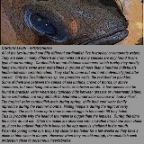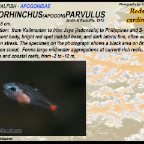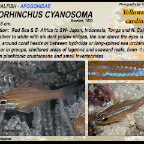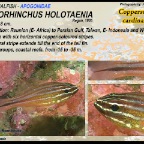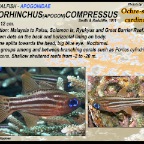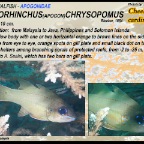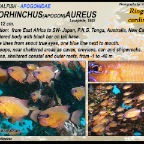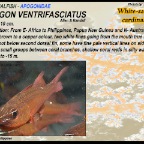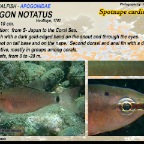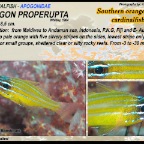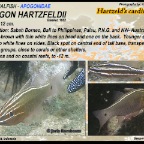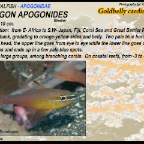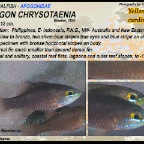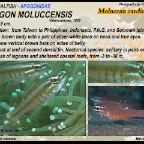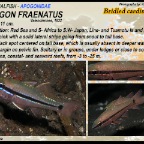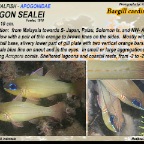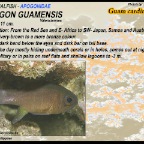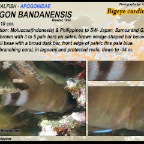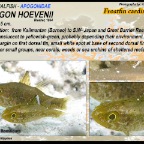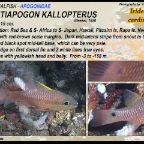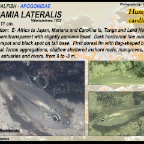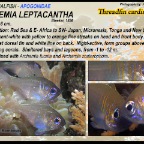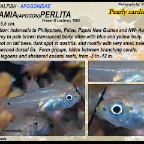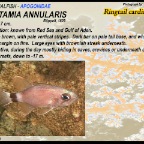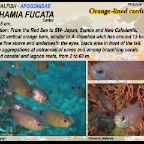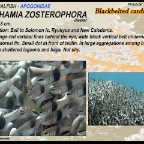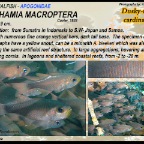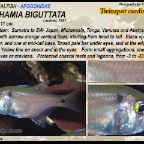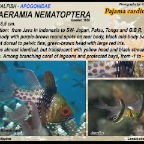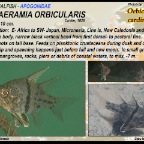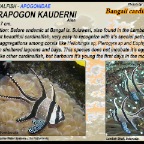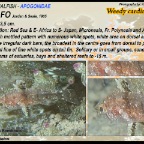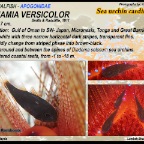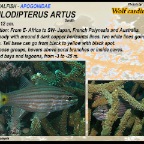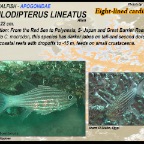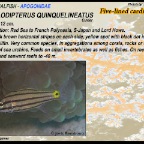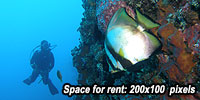CARDINALFISH - APOGONIDAE
All of the two hundred and fifty different cardinalfish live in tropical or temperate waters. They are seen in many different environments but many species are only found in one type of surrounding. Cardinalfish are not distance swimmers which is why they mostly hang around the same area; sometimes in groups of more than a hundred individuals hidden between coral-branches. They start to come out and hunt individually just after sunset. Only the Cheilodipterus sp. are predators while, the rest feed on plankton. Some of them live between the spines of sea urchins, crown of thorns, or above anemones, but most hang out around rocks or between corals. A few species can be found in brackish water where they typically hide between grasses or underneath jetties. Some cardinalfish are very difficult to determine underwater because of ‘look-a-likes’. The tropical water cardinalfish mate during spring, while their cold water family reproduce during the summer months. Mating happens during the night or early mornings. The male keeps up to three hundred eggs in his mouth till they hatch. This is probably why the head of the males is bigger than the females. During this time, the males do not eat. Often the males are observed with a swollen throat and seen close-up, it can be noticed that this is because the egg mass is sheltered in the mouth. When the young come out, they stay close to the father for a few weeks so they have a place to hide when in danger. However when they are old enough, the small fish seek protection close to poisonous invertebrates. Length: 8,5 cm.
Distribution: from Java in Indonesia to SW- Japan, Palau, Tonga and G.B.R.
Silvery body with purple-brown round spots on rear body, black mid-body bar going
from first dorsal to pelvic fins, green-brown head with large red iris.
Juveniles almost identical, but translucent with yellow head and black streak above
the eyes. Among branching coral of lagoons and protected bays, from -1 to -14 m.
Length: 10 cm.
Distribution: from E- Africa to Kiribati, Ryukyus, Mozambique and Great Barrier Reef.
Silverish body, narrow black vertical band from first dorsal- to pectoral fins.
In small groups among mangroves, rocks, piers or debris, to max. -7 m Length: 7 cm.
Distribution: Gulf of Oman to SW- Japan, Micronesia, Tonga and Great Barrier Reef.
Silvery-white with three narrow horizontal dark stripes, transparent fins.
Can rapidly change from striped phase into brown-black.
Shelter around and between the spines of Diadema setosum sea urchins.
On sheltered coastal reefs, from -1 to -18 m. Length: 12 cm.
Distribution: Red Sea to French Polynesia, S-Japan and Lord Howe.
Five dark brown horizontal stripes on each side, yellow spot with black dot infront
of the tailfin. Very common species, in aggregations among corals, rocks or the
spines of sea urchins. Feeds on small invertebrates as well as fishes. On reef flats,
lagoon and seaward reefs to -40 m. Length: 22 cm.
Distribution: from the Red Sea to Polynesia, S- Japan and Great Barrier Reef.
Similar to C. macrodon, this species has darker lobes on tail-and second dorsal fin.
Among coastal reefs with dropoffs to -15 m, feeds on small crustaceans. Length: 12 cm.
Distribution: from E- Africa to SW- Japan, French Polynesia and Australia.
Silvery body with around 8 dark copper horizontal lines. two white lines going over
the eyes. Tail base can go from black to yellow with black spot.
Forms loose groups, hovers above coral branches or inside caves.
Sheltered bays and lagoons, from -3 to -25 m. Length: 8 cm.
Distribution: Bali to Solomon Is, Ryukyus and New Caledonia.
Two orange-red vertical lines behind the eye, wide black vertical belt underneath the
second dorsal fin. Small dot in front of tailfin. In large aggregations among branching
corals in sheltered lagoons and bays. Not shy. Length: 7 cm.
Distribution: before endemic at Bangai Is. Sulawesi, also found in the Lembeh Strait.
The most beautifull cardinalfish, very easy to recognize with it’s special pattern.
In large aggregations among corals like Heliofungia sp, Plerogyra sp and Euphyllia sp.
Found in sheltered lagoons and bays. This species does not incubate it’s eggs in the
mouth like other cardinalfish, but harbours it’s young the first days in the mouth. Length: 9 cm.
Distribution: from Sumatra in Indonesia to S.W- Japan and Samoa.
Grey with numerous fine orange vertical bars, dark tail base. The specimen on the
photographs have a yellow snout, can be a mix with A. bleekeri which was also seen
hovering the same artificial reef structure. In large aggregations, hovering above
branching corals. In lagoons and sheltered coastal reefs, from -2 to -20 m.
Length: 8 cm.
Distribution: from the Red Sea to SW- Japan, Samoa and New Caledonia.
Around 23 vertical orange bars, similar to A. lineolata wich has around 13 bars.
Fine blue line above and underneath the eyes, black area in front of the tail.
In dense aggregations at entrances of caves and among branching corals.
Sheltered coastal and lagoon reefs, from 2 to 60 m. Length: 9 cm.
Distribution: from Taiwan to Philippines, Indonesia, P.N.G. and Solomon Islands.
Silvery-brown body with a pair of silver-white lines on head and true eyes.
Often show vertical brown bars on sides of belly.
White spot at end of second dorsal fin. Nocturnal species, solitary in pairs or in group.
Silty areas of lagoons and sheltered coastal reefs, from - 3 to -30 m. Length: 10 cm.
Distribution: from E- Africa to Philippines, Papua New Guinea and N- Australia.
Silvery-brown to a copper colour, two white lines going from the mouth true the eyes.
White spot below second dorsal fin, some have fine pale vertical lines on sides.
Lives in small groups between coral branches, shallow coral reefs in silty water.
From -3 to -15 m. Length: 10 cm.
Distribution: from Malaysia towards S- Japan, Palau, Solomon Is. and NW- Australia.
Pale yellow with a pair of thin orange to brown lines on the sides. Mostly with dark
spot on tail base, silvery lower part of gill plate with two vertical orange bars.
Bright pale blue line on snout and in the eyes. In small or large aggregations, among
branching Acropora corals. Sheltered lagoons and coastal reefs, from -2 to -25 m. Length: 10 cm.
Distribution: from Bali to the Philippines and NW- Australia.
Pale yellow body with two horizontal orange to brown lines on the side.
Blue line from eye to eye, two orange bars on gill plate and small black dot on tail
base. In small groups among branching corals and small holes, shallow sheltered
reefs. From -2 to -25 m. Length: 8,5 cm.
Distribution: from Maldives to Andaman sea, Indonesia, P.N.G, Fiji and E- Australia.
Yellow to pale orange with five silvery stripes on the sides, lowest stripe only on head.
In pairs or small groups, sheltered clear or silty rocky reefs. From -3 to -30 m.
Length: 10 cm.
Distribution: Red Sea to French Polynesia, S- Japan and New Caledonia.
Stripes can be yellow or white. During the day mostly in holes or sheltered areas.
Solitair or in aggregations in shallow seaward reefs and sheltered lagoons, 2 to -20 m. Length: 6 cm.
Distribution: Red Sea to Samoa, Ryukyus, New Caledonia and Tonga.
Light blue belly, yellow-blue vertical stripes behind the eye. First dorsal fin has a
sharky look.
In large aggregations among branching corals in sheltred lagoons and bay’s. Length: 5 cm.
Distribution: from Kalimantan (Borneo) to S.W- Japan and Great Barrier Reef.
From translucent to yellowish-green, probably depending their environment.
White margin on first dorsal fin, small white spot at base of second dorsal fin.
In pairs or small groups, near corals, weeds or sea urchins of sheltered reefs to -30 m. Length: 12 cm.
Distribution: Sabah Borneo, Bali to Philippines, Palau, P.N.G. and NW- Australia.
Greyish-brown with thin white lines on head and one on the back. Younger specimen
have two white lines on sides. Black spot on central end of tail base, transparent fins.
In small groups, close to corals or other shelters.
In lagoons and on coastal reefs, to -12 m. Length: 11 cm.
Distribution: from the Red Sea and E- Africa to SW- Japan, Samoa and Australia.
From silvery-brown to a more bronze colour.
Narrow dark band below the eyes and dark bar on tail base.
During the day mostly hiding underneath corals or in holes, comes out at night.
Lives solitary or in pairs on reef flats and shallow lagoons to -3 m. Length: 11 cm.
Distribution: Red Sea and S- Africa to S.W- Japan, Line- and Tuamotu Is and Australia.
Silvery-pink with a solid lateral stripe going from snout to tail base.
Large black spot centered on tail base, which is usually absent in deeper water.
White margin on pelvic fin. Solitary or in groups, under ledges or close to coral heads.
In lagoons, coastal- and seaward reefs, from -3 to -25 m. Length: 12 cm.
Distribution: Malaysia to Solomon Is, Ryukyus and Great Barrier Reef.
Red-brown dots on the back and horizontal lining on body. Upper line is devided
towards the head, big blue eye. In small groups among branching corals, shallow
sheltered reefs from 0.3 to -7 m. Length: 10 cm.
Distribution: from Malaysia to Java, Philippines and Solomon Islands.
Pale yellow body with one or two horizontal orange to brown lines on the side.
Blue line from eye to eye, orange spots on gill plate and small black dot on tail base.
Mostly shelters among branching corals of protected reefs, from 2 to -25 m.
Similar to A. Sealei, which has two bars on gill plate. Length: 10 cm.
Distribution: Moluccas(Indonesia) & Philippines to SW- Japan, Samoa and G.B.R.
Copper-brown with 3 to 5 pale bars on sides, brown wedge-shaped bar below eyes.
White tail base with a broad dark bar, front edge of pelvic fins pale blue.
Among branching coral, in lagoons and protected reefs, down to -34 m.
Length: 12 cm.
Distribution: from East Africa to SW- Japan, Tonga and East Australia.
Gold-colored body with black bar (narrows in the middle) on tail base.
Two blue lines from snout true eyes, one blue line next to mouth.
Form groups, near sheltered areas as caves, crevices car- and shipwrecks.
In lagoons, sheltered coastal and outer reefs till -40 m. Length: 10 cm.
Distribution: from E- Africa to S.W- Japan, Fiji, Coral Sea and Great Barrier Reef.
Pinkish back, gradating to orange-yellow sides and belly. Two pale blue horizontal
lines on head, the upper line goes from eye to eye while the lower line goes over the
gill-plates and ends up in a few pale blue spots.
Lives in large groups, among branching corals. On coastal reefs, from -3 to -40 m. Length: 8 cm.
Distribution: from Kalimantan to Irian Jaya (Indonesia) to Philippines and S- Japan.
Translucent body, bright red spot mid-tail base, and dark lateral line, often with silver
or golden streak. The specimen on the photograph shows a black area on first dorsal
fin, and on snout. Forms large mid-water aggregations at current-rich reefs.
Lagoons and coastal reefs, from -2 to -12 m.



